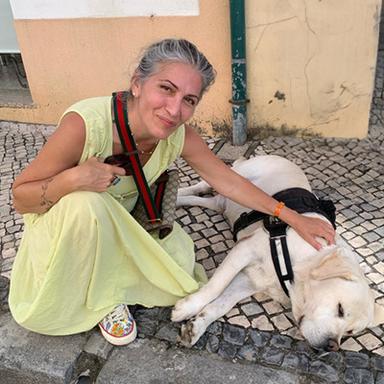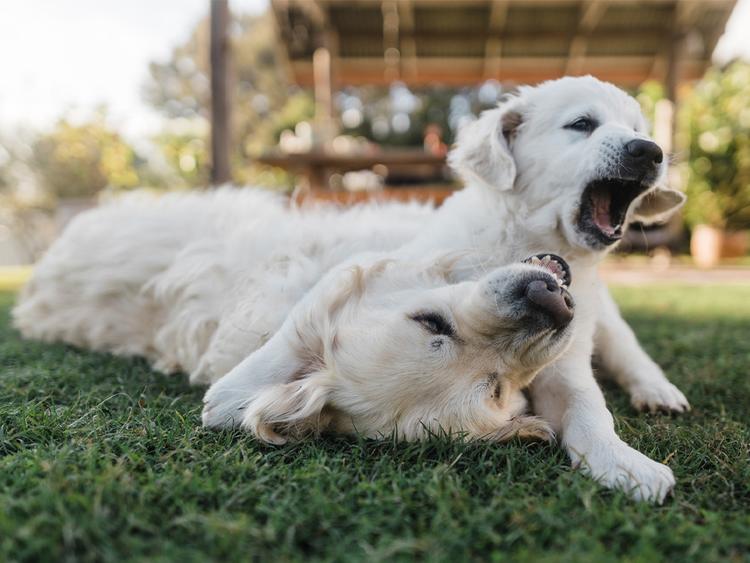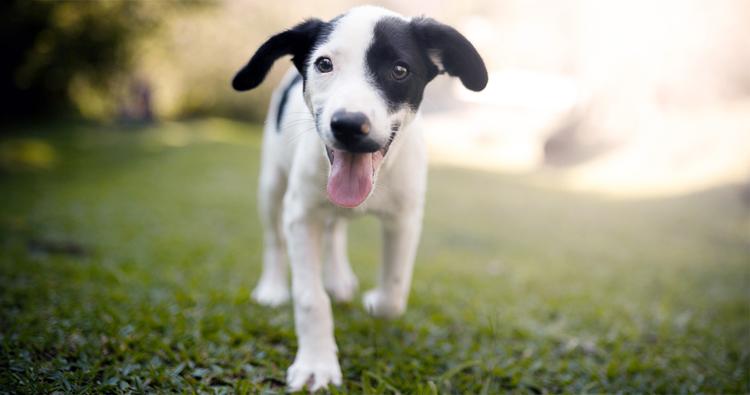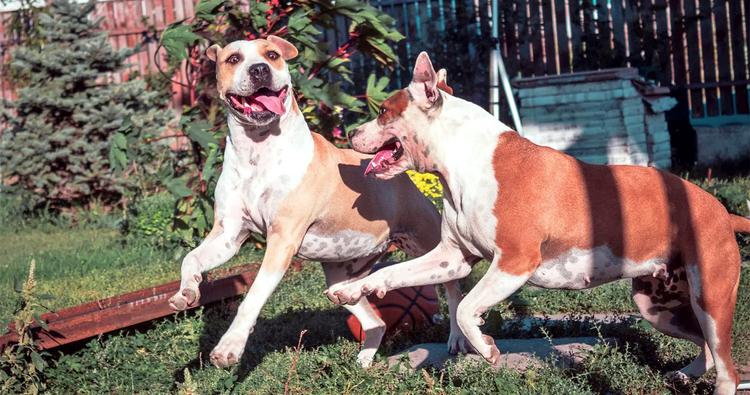How to Introduce a New Puppy to Your Dog
Adopting a new puppy can shake-up the doggy dynamics at home. Here’s how to keep the peace and harmony among your pets.
Adopting a new puppy can shake-up the doggy dynamics at home. Here’s how to keep the peace and harmony among your pets.
by Vivian Zottola, MSc, CBCC, | April 14, 2024

redstallion / iStock
After you adopt a new puppy, you may need to introduce them to any adult dogs in your home (not to mention other dogs when you’re out and about). Considering your existing pet’s feelings and planning the introduction process thoughtfully can go a long way in establishing trust and a healthy, harmonious relationship between your pets. Introducing dogs changes family dynamics in considerable ways. This introduction process can be tricky, but there are strategies to ensure a positive transition and to establish strong bonds between all your pets. Let’s explore some effective methods.
The least stressful way to introduce a new pup to your resident dog is by starting with an introduction to the new puppy odor and sounds — if possible, before any physical contact is made. Dogs rely on their natural abilities (including, first and foremost, their senses of smell) to understand their environment and gather information. Dogs gather pheromones and other chemical cues that dogs and people release, while collecting other sensory information. This specifically helps dogs understand one another’s age, gender, and other biological information. When introducing a new puppy to a resident dog, it’s essential to gradually allow the resident dog to acclimate to the new puppy scent-first, before they meet in person. The goal is to pair a good experience with the new puppy odor (and the sound of the new puppy) before introducing them in a safe way in person.
Before bringing your new puppy home, pick up any toys, chews, or other items belonging to your resident dog. Use baby gates to physically separate the puppy from the resident dog. During this time, you should carefully observe their body language before allowing them to interact.
Start by collecting scents from the new puppy’s sleep or play area. Place a towel or small blanket for the puppy to rest on, which easily captures their scent. After a few days of continued use, put the towel in a plastic bag.
To help your resident dog adjust to an in-person meeting with your new puppy, start by playing soothing sounds that will accompany the puppy’s scent. Classical music has been shown to promote calmness in dogs, making it an excellent choice to play before introducing the new-puppy smell. iCalmPet’s bioacoustics music is a great option, too, since it consists of classical compositions slowed down to mimic the rhythmic heartbeat of resting dogs. You can also try playing soothing nature sounds, such as waterfalls and chirping birds, all of which can calm dogs.
Once you’ve established a pleasant-sound environment, open the plastic bag and place the towel or blanket, infused with the new puppy’s scent, on the resident dog’s bed or favorite place to lay. Follow this action by placing high-value food or a chew on the towel or blanket next to your dog. If you have a recording of your new puppy’s sounds, play it at a low volume and at a distance from the towel and resident dog. Observe your resident dog’s response. Ideally, it’s best to allow your dog freedom to explore these sounds and the puppy-scented towel or blanket (usually by chewing on it) on their own, rather than forcing them to engage with these new stimuli.
Note: If your resident dog stops chewing and is alerted to the noise of the puppy sounds, the volume is too loud and should be adjusted. The goal is to have a relaxed dog chewing on the towel. A gradual introduction to the scent and sounds of the new puppy may help your resident dog accept the latest addition to your family more easily once they come face to face. So repeat this step until it’s the day they meet.
Remember that the puppy may be very eager to meet the adult dog. They may want to jump on them or lick their muzzle, a pacifying behavior that displays appeasement and respect. This is normal behavior for young dogs, but it’s critical that the adult dog is comfortable with the interaction before allowing the two to physically engage and play together. Because our goal is to emotionally protect both puppy and adult dog, you must give the adult dog a chance to smell the young dog, while physically blocking the latter from jumping up on the older dog. That’s why smelling the puppy towel while enjoying something good (Step 4) can help get this relationship off to a good start.
Start the introduction on either side of the doggy gate. Observe the interaction closely: Dogs will use low-level stress signals to communicate when they need space. In times when emotions are high, whether happy or distressed, distance is essential to allow the resident dog time to process this new encounter without feeling threatened.
Some signs of stress in dogs may include:
Yawning
Panting
Lip-licking
Paw-lifting without being asked
Pacing
Freezing, or not moving at all
Growling
Upon noticing any of these stress signals, gently motivate the resident dog to move further away. If you’re versed in mechanical dog-training skills, you can use hand targets or simply lure them away with food.
However, if both dogs are smelling each other with their tails wagging and seem interested in approaching each other, you can remove the gate to allow them access. But if the dogs move away or avoid each other without displaying any stress signals, that’s okay too. Dogs have their own timeline, and you must set up the relationship for success by being patient and understanding their needs. Relationships are built on trust: While you might expect an adult to fall for a puppy, that’s not always the case.
The relationship between dogs of different ages can be heartwarming. A young dog can bring more energy into an older dog’s life. And an older dog can help puppies learn social cues and other essential skills. Introducing dogs of any age to each other requires careful attention to their emotional and physical needs to avoid stress, especially for seniors.
Both dogs are at vulnerable stages in life, operating with different physical and cognitive skills and learning histories. A puppy is in the stage of life where they are developing, and the senior is in a stage of life where they’re moving a little slower, experiencing cognitive decline, hearing or sight loss, or suffering from medical issues such as arthritis.
Meanwhile, a hyperactive, playful puppy is all about exploring boundaries and learning from trial and error. They could jump on a senior dog, which may cause pain and distress. The senior dog might respond by barking as a warning or even biting the puppy. The experience could fracture the relationship before even starting. A big bark or bite from a senior dog may be scary for a puppy, conditioning a fear response that could last a lifetime.
To introduce a puppy to a senior dog, start with the same strategy, above. Provide the resident senior dog with something, like a towel or blanket, that smells like the puppy. Establish positive associations with the smell, days before they meet in person. Separating the dogs at home with a baby gate is still important, because it gives both dogs the ability to see and smell each other, with the freedom to choose to greet each other or not.
Taking a thoughtful approach and following the necessary steps to provide both dogs with a safe, positive introduction is essential for long-term success, especially with these age and energy differences. Ultimately, it will be up to the two dogs to decide if they wish to engage, and the best you can do is set them up for success.
If the above introduction processes aren’t working, take a deep breath, there are still other strategies to support a trusting, calm relationship.
Keep in mind that your dogs — especially the resident dog — may simply need more time to adjust to this change. With this in mind, try the above introduction processes again, but this time do it even more gradually. Often, something as simple as patience will do wonders.
There’s a technique called BioFeedback Protocol that you can try at home. It gradually teaches dogs to remain calm in the presence of other people, dogs, and unexpected environmental changes like movements. You start by feeding each dog treats when they’re sitting or lying down, and gradually increase the duration between feeding. It rewards them for exhibiting calm behaviors. While doing this, continue to keep the dogs separated between gates, and observe their reactions to each other. The goal is to ease into introduction as a positive experience for both dogs.
Each relationship between dogs is unique, and it is essential to support them while they figure out that relationship on their own. Trust and safety are the foundation of any relationship. And it might take some time for adult dogs to accept a puppy, depending on their personalities. While some adult dogs are more patient, others might be put off by the playful advances of a puppy. Patience is key, and it is important to continue providing support and care to both dogs.
However, if even this method isn’t working, you might want to consider reaching out to a professional trainer or behaviorist to implement more nuanced methods.
After the two dogs start to like each other, you’ll notice some advantages. These include:
Mental stimulation: Preventing cognitive decline and reducing stress in older dogs
Keeping the older dog active: Deterring the onset of certain health conditions
Free puppy training: With the older dog showing the pup “the rules”
Introducing a New Dog to Your Current Dog
Introducing a New Dog to Your Dog at Home
Manual of Clinical Behavioral Medicine for Dogs and Cats
Puppy Parties and Beyond: The Role of Early Age Socialization Practices on Adult Dog Behavior
Puppy Socialization and Early Exposure
Sensory Stimulation as Environmental Enrichment for Captive Animals: A Review
Smelling More or Less: Investigating the Olfactory Experience of the Domestic Dog
Through a Dog’s Ear: Using Sound to Improve the Health & Behavior of Your Canine Companion

Vivian Zottola, MSc, is an applied anthrozoologist, dog psychologist, member of the Dog Writers Association of America, and research associate with the Center for Canine Behavior Studies, Inc. She runs her own practice in Boston, MA, specializing in the prevention and resolution of behavior challenges between humans and pet companion dogs. She also produces the podcast Click Therapy for Dogs and the People Who Love Them. Find her on Instagram.

Adoption Advice

Adoption Advice

Behavior & Training

Adoption Advice
Did you just bring home an adorable puppy?

Adoption Advice
Here’s everything there is to consider before adopting a second dog.

Adoption Advice
Find out how to set your adopted rescue dog up for success.